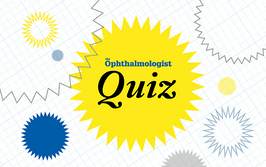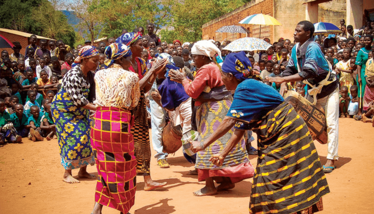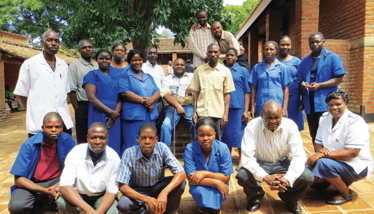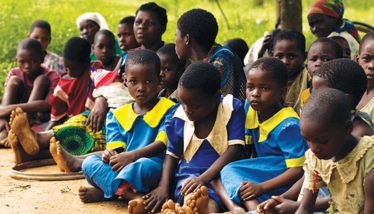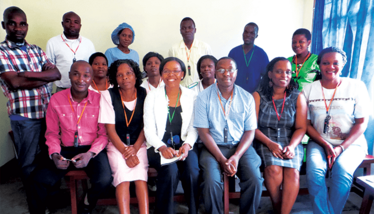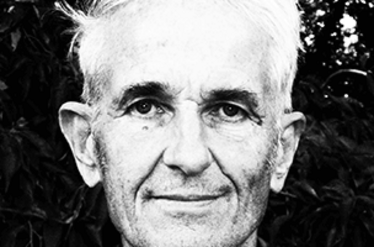
I’ve always been interested in the challenges of developing country ophthalmology and avoidable world blindness. Before becoming a consultant ophthalmologist at Leicester Hospital in the UK, I’d had a rather unusual career spending nine years overseas in Pakistan and Nigeria. I’d seen first-hand the totally different disease spectrum in the developing world; vitamin A deficiency, post-measles keratitis, onchocerciasis, trachoma and fungal keratitis (to name a few of the worst) were all extremely common in some areas and you just wouldn’t see them in many developed countries. The burden of preventable and treatable eye disease was also huge. Reflecting on this, I realized that there was no available resources for working and teaching in developing countries, which stimulated me to write two textbooks (“Eye Diseases in Hot Climates” and “Eye Surgery in Hot Climates”). Over the years, I ended up spending three to four weeks each year in different countries, so I kept my focus on the problems in the developing world. In 1997, I was working in a hospital in Gondar (Ethiopia) and, as far as I could discover, there was only one ophthalmoscope in the entire teaching hospital – one that served around 10 million patients! Outside of the teaching hospital, there wasn’t any quality eyecare at all. “Something needs to be done about this,” I thought.
A good friend of mine, the late Alexander (Sandy) Holt-Wilson, had also spent time in Gondar and realized there was a desperate need for a basic low-cost ophthalmoscope, so together we started to hunt for one. Guided by an article by Roger Armour on the manufacture and use of homemade ophthalmoscopes in the Christmas edition of the BMJ (1), we had discovered a person who was making homemade ophthalmoscopes with cardboard rolls and mirrors. Following some encouragement from us, he secured some funding to develop a lower cost device, but unfortunately the end result was still too expensive at around £65 (~€80).
We continued our hunt and finally met William J Williams, a bright young optometrist with an interest in electronics and design. He’d patented the idea of using LEDs rather than filament bulbs in ophthalmoscopes and had the idea of using solar panel charging. Listening to advice from several of us, William further developed his ideas and the Arclight was born (See Box “Introducing the Arclight”).
Introducing the Arclight
- The device measures 4.3 × 1.0 × 0.35" (110 × 26 × 9 mm) and weighs 0.63 oz (18 g).
- Features: solar panel, LEDs (warm-white, daylight white, blue/violet), ×4 magnification loupe, lenses and filters, near VA chart, specula (4.5 mm and 2.5 mm), USB port.
- The device is available to low-income countries from ~€6/£5 per unit through the IAPB. It is also available in the UK and Europe from the University of St Andrews online shop.
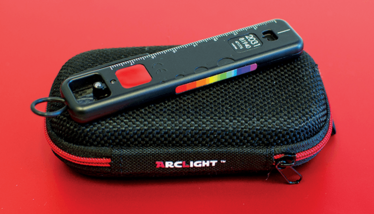
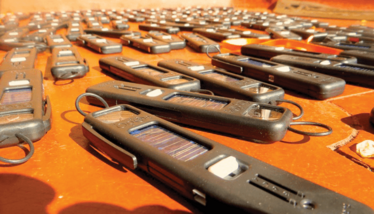
Arclight devices charging in the sun
Sandy was good friends with Richard Le Mesurier, Medical Director of the Fred Hollows Foundation, and he too became very interested in the device. The Foundation gave William £100,000 (~€125,000) to develop his prototypes. They wanted 5,000 devices and, much to their surprise, William developed everything and produced them. Andrew Blaikie (one of my juniors in Leicester) became intrigued by the device; and his clinical studies have shown that many find the Arclight just as good as the much more complex conventional direct ophthalmoscope.
So far, the device has had the biggest impact in the developing world. When we submitted our recent article to the BMJ (2), we received a mix of referee comments, but one of the positive reviewers had themselves visited an eye department in Nigeria and seen that doctors were queuing up to use the one – and only – ophthalmoscope. She realized the potential impact of handing Arclight devices to everybody... Providing simple, robust, easy-to-use medical equipment to those who really need it is where the biggest changes must occur. I also hope that the device will have an impact on medical students. Throughout 2015 and 2016 there was an ongoing debate published in Eye about whether ophthalmoscopy should even be taught to students. More than a handful of people thought it shouldn’t; the direct ophthalmoscope has rather gone out of favor as other technologies have ‘superseded’ it. They argued that patients with eye problems should be referred rather than examined, which I thought was a rather defeatist attitude. If we boost training so that medical students are more confident in performing ophthalmoscopy and diagnosing basic problems in the eye, I believe it would be a very positive step forwards for medical school training – as well as the health service.
The Arclight is an interesting story, but the story has not yet been fully told. Right now, we have various ideas in the pipeline; William wants to make some improvements to the device and we’re planning to include in-built memory with educational content. Given that there is such a need for training people at a grassroots level in Africa, I’ve been working with another group here in Leicester to produce a multimedia training program about how to manage eye disease. It’s currently available on DVD and online, but loading it onto the Arclight will give people a mini textbook guide – all in this little device that fits in their shirt pocket.
I am excited that I have been a small piece in the jigsaw. The key player is William; he has done everything himself – designing, prototyping, developing, sorting out the patents and CE marking, and visiting manufacturers in Hong Kong and China. He’s done so much – he’s really interested in making a difference globally.
John Sandford-Smith is an emeritus Consultant Ophthalmologist at Leicester Royal Infirmary. He is a widely-respected expert on eye diseases and has been extensively involved in teaching, training and voluntary work, both during his career and since his retirement in 2000. In 2007, he received an MBE for services to blind people in developing countries.
Richard Le Mesurier holds the IAPB Western Pacific Chair, and is the Fred Hollows Foundation Medical Director. He has huge worldwide experience – from Africa to the Pacific – with an interest in trachoma, cataract surgical training, and medical innovation.
The late Alexander (Sandy) Holt-Wilson was a Consultant Ophthalmologist, and founder and chairman of the charity: Gondar (Ethiopia) Eye Surgery (GEES). GEES supported Gondar University and also the emerging Optometry school. He was pivotal in linking people and groups together.
Making a Difference Globally by John Sandford-Smith
Getting the Idea Out There byAndrew Blaikie
Bringing the Idea to Life by William J Williams

Arclight devices charging in the sun
- RH Armour, “Manufacture and use of homemade ophthalmoscopes: a 150th anniversary tribute to Helmholtz”, BMJ, 321, 1557–1559 (2000). PMID: 11124172.
- A Blaikie et al., “Arclight: a pocket ophthalmoscope for the 21st century”, BMJ, 355, i6637 (2016). PMID: 27974424.
John Sandford-Smith is an emeritus Consultant Ophthalmologist at Leicester Royal Infirmary. He is a widely-respected expert on eye diseases and has been extensively involved in teaching, training and voluntary work, both during his career and since his retirement in 2000. In 2007, he received an MBE for services to blind people in developing countries.



